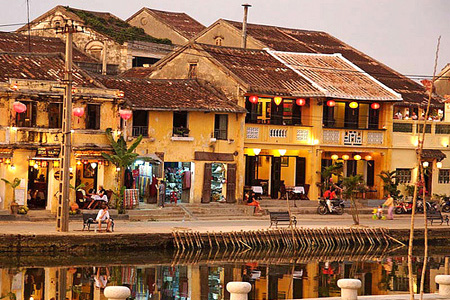Hoi An is recognized the second-best cities in Asia
Hoi An is ancient town which was well-known on the international market with many different names such as Lam Ap, Faifo, Hoai Pho and Hoi An. It is recognized as World Heritage Site by UNESCO in 1999. And now, Hoi An was voted one of the Asia’s top cities by Conde Nast Traveler readers.

The ranking was based on culture, friendliness, atmosphere, restaurants, lodging and shopping.
The 10 cities under consideration were Kyoto and Tokyo in Japan, Hoi An in Vietnam, Ubub in Indonesia, Luang Prabang in Laos, Singapore, Chiang Mai and Bangkok in Thailand, Hong Kong in China and Siem Reap in Cambodia. Kyoto placed first. Hoi An was second.
The reader was admired by the architecture of Hoi An and they love the colorful houses as well as the quiet atmosphere.
The architecture of Hoi An, which is almost entirely of wood, is of considerable interest. It combines traditional Vietnamese designs and techniques with those from other countries, above all China and Japan, whose citizens settled there to trade and built houses and community centres to their own designs.
The typical house conforms to a corridor plan, the following elements occurring in sequence: house, yard and house. There is a fine wooden bridge, reminiscent of Japanese examples, with a pagoda on it. It has existed from at least the early 18th century, as an inscription indicates, but it has been reconstructed many times. There is also a number of ancient tombs in Vietnamese, Japanese and Chinese style within the buffer zone.

Hoi An has long been a cultural crossroad. More than five centuries ago the Vietnamese nation of Dai Viet expanded its territory southwards, encroaching on the Indianized Kingdom of Champa, which covered much of what is now central Vietnam. These diverse cultural influences remain visible today.
Visitors will find Hoi An’s Old Quarter lined with two-storey Chinese shops, their elaborately carved wooden facades and moss-covered tile roofs having withstood the ravages of more than 300 years of weather and warfare. These proud old buildings, which back onto the river, remind visitors of another era, when Hoi An’s market was filled with wares from as far afield as India and Europe. Colourful guildhalls, founded by ethnic Chinese from Guangdong and Fujian provinces, stand quietly, a testament to the town’s trading roots.

While Hoi An’s old-fashioned charm is always visible, on the 15th of every lunar month modernity takes another step back. On these evenings the town turns off its street lamps and fluorescent lights, leaving the Old Quarter bathed in the warm glow of colored silk, glass and paper lanterns. In ancient times, Vietnamese people made lamps out of shallow bowls filled with oil. Later, foreign traders introduced lanterns, ranging from round and hexagonal designs from China to diamond and star shaped ones from Japan.
Things to do in Hoi An:
Start planning your tailor-made Vietnam tour by contacting one of our specialists…







